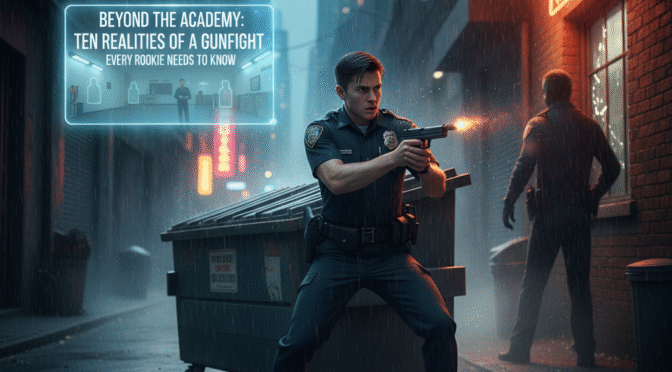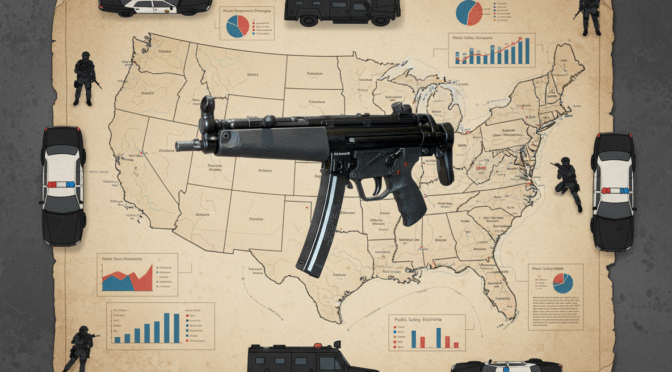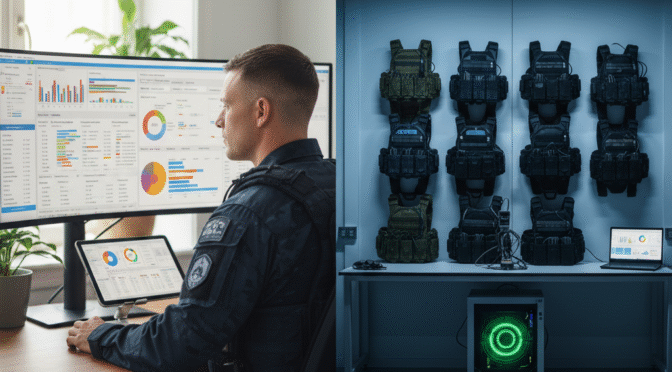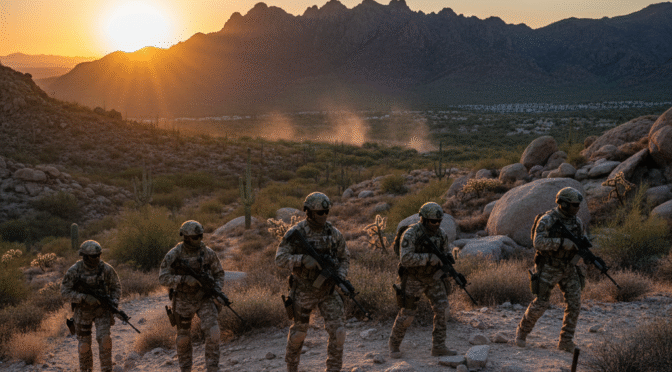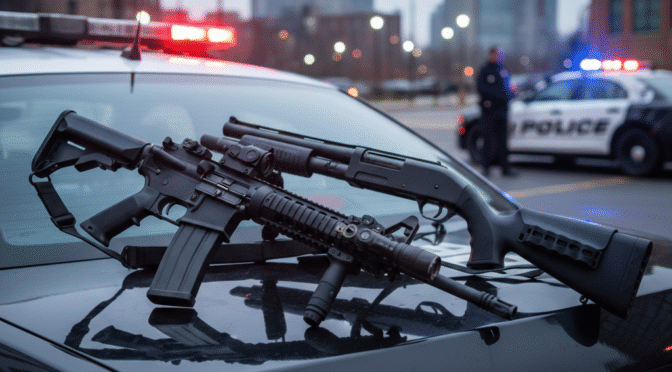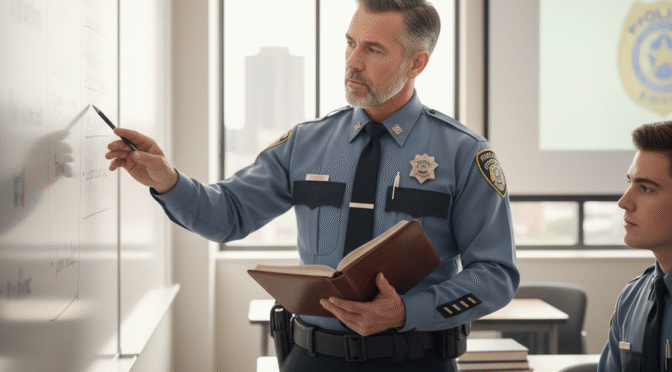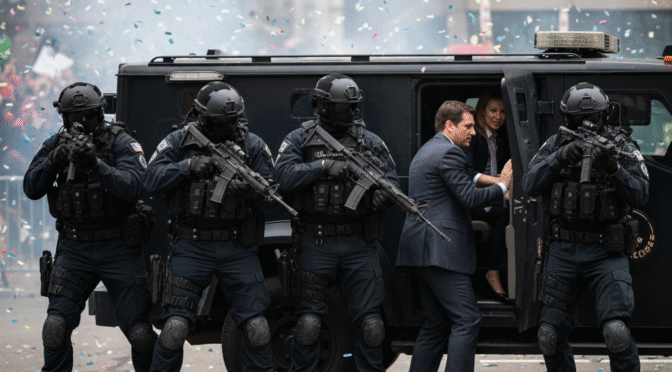This report is intended to bridge the critical gap between academy instruction and the chaotic, high-stress reality of a lethal force encounter. Its purpose is not to replace foundational training but to augment it with hard-won lessons from the street, scientific research into human performance, and after-action reviews of pivotal incidents. Survival in a gunfight is not a matter of luck. It is the direct result of a superior combat mindset, realistic training that inoculates against stress, and a deep, unflinching understanding of the ten realities detailed herein. For the rookie officer, internalizing these lessons is a non-negotiable component of going home at the end of every shift.
1. Your Brain and Body Under Fire: The Science of Combat Stress
A lethal force encounter triggers a massive, involuntary neurochemical dump that fundamentally alters an officer’s perception, cognition, and physical capabilities. Understanding these changes is the first step to managing them. Most officers who have been involved in a deadly force shooting describe one or more alterations in perception, thinking, and behavior. These are not signs of failure but predictable physiological responses to extreme emergency stress.
Key perceptual distortions include tunnel vision, where the officer’s focus narrows intensely on the perceived threat—typically the suspect’s weapon or hands—while blocking out everything in the periphery. This explains why an officer may not see a secondary threat or even their own partner. Auditory exclusion is also common, where sounds may seem muffled, amplified, or are not heard at all; officers frequently report not hearing their own or other officers’ gunshots. Furthermore, officers often experience time distortion, with the majority recalling the event as occurring in slow motion, though a smaller percentage report it speeding up.
Cognitively, officers may experience a sense of dissociation, describing their actions as being on “automatic” or feeling as if they were observing the event from outside their own body. This “mental autopilot” is the brain’s way of functioning when conscious processing is overloaded, relying instead on ingrained training. A direct consequence of this hyper-aroused state is significant memory impairment. Recall for parts of the incident, or even one’s own actions, is often fragmented, distorted, or completely absent. This is compounded by the degradation of fine motor skills, which are essential for complex weapon manipulations, even as gross motor skills like running are enhanced by adrenaline.
These physiological realities create a fundamental conflict with the procedural demands of the post-incident investigation. The investigative process, which includes criminal, administrative, and civil reviews, is built upon the assumption of perfect, linear, and objective recall from the involved officer. The officer’s statement is a cornerstone of these reviews, yet the system demands a level of clarity that the officer’s brain is physiologically incapable of providing in the immediate aftermath. An officer’s fragmented or distorted memory is not evidence of deception but a scientifically documented symptom of trauma. Therefore, rookies must be trained not only to fight but to articulate these phenomena. Possessing the vocabulary to explain why their memory has gaps or their perception of time was altered is a critical career survival skill for navigating the “second fight” that begins after the last shot is fired. This knowledge transforms an officer from a potentially “unreliable witness” into an educated professional explaining the known effects of human performance under duress.
2. The Myth of the Perfect Shot: Marksmanship vs. Gunfighting
The skills that earn a perfect score on a static qualification range often have little bearing on survival in a dynamic gunfight. Gunfighting is not precision marksmanship; it is a violent, close-range, and often one-handed affair. Analysis of thousands of officer-involved shootings reveals that lethal encounters are overwhelmingly close-quarters events. Data from the New York City Police Department’s (NYPD) SOP 9 reports show that 69% of shooting incidents occur at a distance of 0-2 yards, with 88% occurring within 7 yards. A veteran Chicago PD officer with experience in 14 gunfights noted that most of his engagements were under 12 feet.
At these distances, the perfect two-handed Weaver or Isosceles stance is a “luxury” seldom achieved in combat. Officers are frequently moving, seeking cover, or using their support hand for other critical tasks like opening a door, using the radio, or fending off an attacker. The same veteran officer reported using a two-handed grip in only two or three of his 14 shootings. Similarly, under the extreme stress of a close-range attack, achieving a perfect sight picture is rare. Data from 1981 indicated that 70% of NYPD officers did not use sight alignment when firing. Officers often revert to “instinctive” or “point shooting,” bringing the weapon to eye level to create a rapid visual index with the target.
Despite these extremely close ranges, hit probabilities are shockingly low. The mean hit rate for NYPD officers in gunfights between 1990 and 2000 was a mere 15%. Even at 0-2 yards, where most fights happen, the hit rate was only 38%. This reveals an inverse correlation between proximity and perceived control. While logic suggests a closer target is an easier target, the data proves otherwise. A gunfight at two yards is not a shooting problem; it is a fighting problem. The extreme proximity introduces variables of explosive movement, the suspect’s actions, the officer’s startle response, and the overwhelming physiological effects of combat stress. It is the proximity itself that generates the chaos that degrades performance more than distance does. Consequently, training must shift its focus from pure marksmanship at these ranges to integrated skills. Close-quarters training must involve force-on-force scenarios, weapon retention drills, and shooting while moving or off-balance to replicate the chaos of a close-range fight, not just its distance.
3. The Lethal Math: Action, Reaction, and the Unforgiving Clock
A suspect’s action will always be faster than an officer’s reaction. This scientific certainty, known as the “reactionary gap,” is one of the most critical and least understood concepts for rookies. Relying on the ability to “react” to a drawn gun is a fatal mistake. Research from the Force Science Institute has extensively documented human performance in lethal encounters, providing hard data on this principle. Studies show a suspect can draw a concealed firearm from their waistband and fire in an average time of just 0.25 seconds. In contrast, an officer with their firearm securely holstered requires an average of 1.71 seconds to draw, get on target, and fire. Even if an officer’s weapon is already drawn and at a “high-ready” position, the response time to return fire averages over 0.8 seconds.
The principle is simple and unforgiving: “Action is faster than reaction every time”. The suspect initiates a pre-planned action. The officer must first perceive that action, process it as a threat, decide on a response, and then physically execute that response. This sequence guarantees the officer will always be behind the assailant’s action-decision curve.
The reactionary gap provides the scientific justification for proactive policing based on pre-attack indicators. The data proves that waiting for a suspect to present a weapon is a losing proposition; an officer will likely be shot before they can effectively respond. Therefore, effective training, such as courses focused on “reading people,” emphasizes identifying pre-attack cues: furtive movements, target glances at an officer’s weapon, “security pats” to check for a concealed weapon, or pre-assaultive postures. Officers are trained to act on these cues to preempt an assault. However, this same principle creates a significant vulnerability for officers in the court of public and legal opinion. A layperson, juror, or prosecutor viewing body-camera footage in hindsight may only see an officer using force against a suspect whose gun was not yet visible. This can lead to accusations of “officer-created jeopardy,” where the officer is blamed for escalating the situation. Rookies must understand that the tactics necessary for survival may look aggressive to the untrained eye. They must be trained to meticulously articulate the specific pre-attack indicators they observed that forced their actions. Their justification for using force began long before the suspect’s gun cleared leather, and their ability to explain this is paramount to surviving both the physical and legal fight.
4. Movement is Life: The Principles of Cover and Dynamic Engagement
In a gunfight, a static officer is a target. Movement is essential for survival—it disrupts the assailant’s aim, creates better tactical angles, and allows the officer to seize the initiative. Cover is not a place to hide, but a position from which to fight effectively. Firing while moving and the proper recognition and use of cover are identified as two of the ten essential skills needed to win a gunfight.
The proper use of cover is a science. It is critical to differentiate between cover and a simple barricade. Resting a weapon on an object for stability is a competition technique that exposes the officer’s head and chest and can induce weapon malfunctions. To minimize risk from ricochets and back-splatter from incoming rounds, officers should maintain a distance of at least three feet from their cover when possible. When engaging a threat from behind cover, exposure must be minimized. The “roll out” technique, where an officer leans out from the waist, exposes only an eye and the gun barrel, not the entire body. Finally, movement must be unpredictable. An officer should constantly change positions and levels (e.g., from standing to kneeling) to prevent the suspect from anticipating where they will reappear.
Cover and movement are not merely defensive tactics; they are offensive tools for managing time and manipulating the adversary’s decision-making process. While the primary function of cover is physical protection from incoming rounds, the principles of how to use cover—moving between positions, changing levels—are about more than just defense. Every time an officer moves, they force the assailant to re-engage their own decision-making cycle. The assailant must find the officer, re-aim, and decide to shoot again, a process that takes time. Therefore, movement is a method of “stealing time” from the attacker. It disrupts their mental cycle and creates windows of opportunity for the officer to act. Rookies should be taught to view movement not as “running away” but as “tactical repositioning.” Training must incorporate drills that force officers to shoot, move, and communicate simultaneously, treating movement as integral to the act of fighting, not a separate action.
5. The Fallacy of the “One-Shot Stop”: Terminal Ballistics and Incapacitation
Handgun rounds are relatively poor incapacitators. Determined, intoxicated, or mentally ill adversaries can absorb multiple, even anatomically fatal, wounds and continue to fight. The objective is not to shoot an assailant, but to stop their threatening actions.
The 2008 gunfight involving Skokie, Illinois, Officer Timothy Gramins is a quintessential case study. His attacker, a bank robber, was struck 17 times with.45 caliber rounds. Six of these wounds were to vital organs—the heart, both lungs, the liver, diaphragm, and a kidney—yet the suspect continued to fight and return fire for nearly a minute. As Gramins later stated, “People don’t die the way we think they do”. The will to win can also overcome grievous injury. Officer Jared Reston was shot seven times, including in the face, yet was able to stay in the fight and neutralize his attacker. These incidents demonstrate that even severe wounds are not guaranteed to stop a determined individual.
This reality debunks the myth of “shooting to wound.” The idea of intentionally aiming for an arm or leg is scientifically, legally, and tactically nonsensical. Limbs are small, fast-moving targets, making an accurate hit highly unlikely under stress. A non-incapacitating hit fails to stop the threat and may only enrage the attacker. The legal standard for use of force is what is “reasonable,” not the “least intrusive method”. The goal must be immediate incapacitation, which generally requires hits to the central nervous system or massive damage to the cardiovascular system. After his first shooting, veteran officer Bob Stash and his partner began training for headshots to “better assure a quicker stop”.
The disparity between physiological incapacitation (a medical state) and tactical incapacitation (the cessation of hostile action) is the primary driver of high round counts in officer-involved shootings. The Gramins case clearly shows a suspect who was medically dying but remained a lethal tactical threat. An officer’s legal and moral justification for using deadly force continues as long as the suspect poses a deadly threat. Therefore, the officer is required to continue shooting until the threatening behavior stops, regardless of how many rounds have already been fired or how wounded the suspect appears to be. This creates a major point of friction with public perception, where a high round count is often misconstrued as excessive force. Rookies must be mentally prepared to shoot until the threat is truly over, and they must be trained to articulate that their actions were dictated by the suspect’s continued aggression, not a desire to be punitive.
6. Forging the Will to Win: The Primacy of a Combat Mindset
In a gunfight, technical skill is useless without the psychological resilience to apply it under unimaginable duress. The “will to win” or “combat mindset” is the single most important factor in survival. This is not hyperbole; it is a conclusion drawn from the actions of officers who survived unwinnable situations.
During the 1986 FBI Miami Shootout, Special Agent Ed Mireles was severely wounded with a disabled arm and a head wound. Despite his injuries, he “raged against the dying of the light,” improvised a one-handed technique to operate his shotgun, and ended the fight. Officer Jared Reston, after being shot seven times, “angrily rose to the occasion and won the gunfight,” refusing to quit. Officer Anna Carrizales, shot in the face and chest, not only returned fire but pursued her attackers and assisted in their capture. These officers survived because they possessed an indomitable will.
This mindset is a trainable skill. Effective training deliberately induces stress to help officers learn to manage it, a process known as stress inoculation. Trainer Chris Ghannam advocates for linking firearms skills to a strong emotional component, such as listening to a message from a loved one before training, to “supercharge your memory” and “mainline right to your will to survive”. He also suggests cultivating an attitude of gratitude—embracing the responsibility of being the one in the crisis rather than recoiling from it—as a powerful psychological asset.
The “will to win” is not an abstract platitude but a tangible skill forged by deliberately exposing officers to failure in a controlled training environment. Effective training involves managing “impaired functionality” and fighting through “externalities”. This means training is designed to be difficult and to push officers to their limits. By experiencing and overcoming difficulty, frustration, and even failure in training—such as fumbling a reload with iced hands or being pelted with tennis balls while shooting—officers build confidence that they can function even when things go wrong. They learn that a mistake is not a catastrophe. Rookies should not fear failure in training; they should seek it out. A training regimen where the officer always succeeds is a “luxury” that builds a “liability”. The true value of training is in learning to problem-solve and fight through adversity, which builds the mental toughness essential for when a real fight goes sideways.
7. The Brutal Arithmetic of Ammunition
The number of rounds carried on duty should not be based on administrative convenience or minimum qualification standards, but on the statistical and anecdotal reality of modern gunfights. These encounters frequently involve high round expenditures to stop resilient threats.
The most powerful lesson comes from Officer Tim Gramins, who went from carrying 47 rounds on duty to 145 “every day, without fail” after his 2008 gunfight. He fired 33 rounds in 56 seconds and was left with only four rounds in his last magazine. He did not view this increased loadout as “paranoia,” but as “preparation”. This decision was a direct result of facing an adversary who simply would not stop despite being hit with numerous rounds.
Statistical data supports this anecdotal evidence. NYPD SOP 9 reports show the mean number of shots fired per gunfight was over 10, with the number escalating since the adoption of higher-capacity semi-automatic pistols. The inefficiency of combat, driven by low hit probabilities (Section 2) and the failure of single shots to incapacitate (Section 5), means that a high volume of fire is often necessary to end a threat. Furthermore, in a sudden ambush, accessing a patrol rifle or shotgun is often impossible. Gramins had both an AR-15 and a Remington 870 in his squad car but could not get to them during the fight. The handgun is the weapon that will be used, so it must be adequately supplied.
An officer’s ammunition loadout is a direct reflection of their agency’s understanding—or lack thereof—of real-world gunfight dynamics. Many agencies issue a standard loadout of three magazines based on tradition or budget, not on an analysis of modern gunfight data. This creates a potential institutional failure. An officer who runs out of ammunition in a gunfight has been failed by a policy that did not equip them for the known realities of their job. Rookies must take personal responsibility for their own survival. While they must adhere to department policy, they should understand the why behind carrying extra ammunition if permitted. It is not about looking “tactical”; it is a data-driven decision based on the high probability of needing more rounds than a standard qualification course would suggest. Ammunition capacity is a critical piece of life-saving equipment, just like a ballistic vest.
8. The Fog of War: Communications, Identification, and Fratricide Risk
A gunfight is not a sterile, one-on-one duel. It is a chaotic event in a 360-degree environment where managing information, communicating with partners and dispatch, and positively identifying threats are as critical as marksmanship.
The 1986 FBI Miami Shootout serves as a stark case study in communications breakdown. The lead agents became so task-saturated with the pursuit and planning the takedown that they failed to provide timely location updates. As a result, responding backup units were delayed by several valuable minutes and arrived too late to influence the outcome of the fight. The same incident highlights the extreme danger of misidentification. The plainclothes FBI agents were difficult for uniformed backup officers to identify as friendlies. The danger spiked dramatically when the felons attempted to escape in an FBI car with its blue emergency light flashing, creating a scenario ripe for a “blue-on-blue” shooting.
The proliferation of legally armed citizens adds another layer of complexity. An officer arriving at a chaotic scene may have difficulty distinguishing a “good guy with a gun” from the suspect. Civilians who attempt to assist law enforcement in a gunfight are at extreme risk of being misidentified and shot by responding officers who arrive “hot” and do not know who is who.
In a gunfight, an officer is not just a shooter; they are a real-time information processor and communicator operating under extreme cognitive load. The Miami Shootout demonstrates that even highly trained agents can fail at basic tasks like communication when overloaded. This highlights that fighting, moving, communicating, and identifying are not separate skills performed sequentially; in a real incident, they must all be performed simultaneously. The human brain is not well-equipped for this level of multi-tasking under life-or-death stress, which leads to critical errors. Therefore, training must reflect this complexity. Simple shoot/don’t-shoot drills are insufficient. Rookies need to be put into team-based scenarios that force them to manage multiple information streams at once. Drills that require officers to provide radio updates while engaging a threat, or scenarios with ambiguous targets that require verbal challenges and identification, are essential to build the cognitive resilience needed to manage the “fog of war.”
9. The Second Fight: Surviving the Aftermath
For an officer, the gunfight does not end when the shooting stops. A second, and in many ways more grueling, fight begins immediately: the administrative, legal, and psychological aftermath. Rookies must be prepared for this marathon. An officer-involved shooting (OIS) triggers multiple, parallel investigations: a criminal investigation of the suspect, a criminal investigation of the officer, an administrative investigation for policy compliance, and often a civil investigation for liability.
The officer’s statement is a crucial piece of evidence in all these proceedings. However, as established in Section 1, memory is profoundly affected by stress. Officers may be unable to provide a perfect, linear account of events, which can be misconstrued by investigators. Agencies are now grappling with this reality; some policies allow officers to review body-worn camera (BWC) footage before giving a statement to aid recall, while others fear it could taint memory and allow for the perception of dishonesty.
An OIS is a profound psychological event that almost always leaves a psychological trace. Departments have a responsibility to provide robust mental health support, including access to licensed psychotherapists and peer support officers. A structured reintegration plan—which may include returning to the scene and firing on the range—can be critical for recovery. Many officers struggle with Post-Traumatic Stress Disorder (PTSD) and survivor’s guilt. Special Agent Ed Mireles took years to “forgive himself” after the Miami Shootout. Historically, a high percentage of officers involved in shootings left law enforcement within five years, though better support systems may be improving this statistic.
The post-OIS process is a system that, while necessary for accountability, is inherently at odds with the human element of trauma and recovery. The goal of the investigative system is to find objective truth through procedural rigor. The officer, the primary source of information, is in a state of psychological trauma where objective truth is clouded by perceptual distortions and memory gaps. This creates an immediate conflict. The officer needs time and support to process the trauma, but the system demands statements and reports immediately to preserve the integrity of the investigation. Rookies must be taught that the aftermath is a formal, legal process, not a casual debriefing. They must understand their rights, such as the right to have an attorney present. They should be trained to report what they remember, and to be comfortable stating what they don’t remember, rather than guessing. Training on how to write a use-of-force report that accurately reflects their perceptions, including the physiological effects they experienced, is a vital and often overlooked survival skill.
10. Training for the Real Thing: Beyond Checking the Box
The ultimate lesson is that survival is a direct product of training. However, not all training is created equal. To prepare officers for the realities outlined in the previous nine sections, training must be realistic, stress-inducing, and focused on integrated decision-making rather than isolated mechanical skills.
Traditional, static range training is repeatedly criticized by combat veterans as “useless” for preparing officers for a real fight because it fails to incorporate movement, stress, or realistic scenarios. Top-tier training uses tools like reactive steel targets and shoot houses with moveable walls to create realistic environments and induce stress. The goal is not stress prevention, but “stress management, one’s ability to proactively manage fluctuating levels of arousal”. Training must move beyond marksmanship to focus on tactics and decision-making in scenario-based learning. It should also incorporate “impaired functionality” drills (e.g., shooting with cold hands) and surprise attacks while the officer is preoccupied with another task to build confidence in one’s ability to perform under degraded conditions. Premier training organizations like Calibre Press offer courses that blend tactical skills with crucial “soft” skills like de-escalation, communication, and managing stress.
A comprehensive training philosophy must prepare officers to transition through the five variables that impede success at the start of any fight: Time, Availability (of the right weapon), Mental State, Environment, and the Enemy’s unknown capabilities. The ultimate goal of training is not to create a perfect operator who never makes a mistake, but to forge a resilient and adaptive problem-solver who can win even when everything goes wrong. A training methodology that demands perfection sets officers up for psychological failure. When an officer trained for perfection makes their first mistake under stress, they may freeze or become frustrated, compounding the problem. In contrast, a training methodology that embraces chaos and teaches officers to “manage impaired functionality” builds adaptability. It teaches them to expect things to go wrong and gives them the tools to improvise, adapt, and overcome, as Ed Mireles did in Miami. The most valuable lesson a rookie can learn in training is not how to shoot a perfect group, but how to clear a complex malfunction under fire, how to fight effectively after being knocked to the ground, and how to communicate vital information while their heart is pounding. The training philosophy must be to “train for chaos, not for qualification.” This builds officers who are not just skilled, but are mentally unbreakable.
Summary Table: The 10 Gunfight Realities
| The Lesson | The Harsh Reality (What Seasoned Officers Know) | Critical Training Implication (What Rookies Must Do) |
|---|---|---|
| 1. Combat is a Biological Event | Your body will betray your training. You will experience tunnel vision, auditory exclusion, time distortion, and memory loss. This is normal, not a failure. | Train to function despite these effects. Learn to articulate these phenomena to explain memory gaps and perceptual distortions during post-incident investigations. |
| 2. Marksmanship is Not Gunfighting | Gunfights are close, fast, and ugly. You will likely be moving, shooting one-handed, and will not have a perfect sight picture. Hit rates are abysmal. | Focus training on close-quarters, dynamic scenarios. Master one-handed weapon manipulations and shooting from unconventional positions. |
| 3. You Cannot Out-React a Bullet | Action is always faster than reaction. A suspect can draw and fire before you can react to their movement. Waiting to see a gun is a death sentence. | Train to recognize and act on pre-attack indicators. Proactive threat management, not reactive speed, is the key to survival. |
| 4. A Static Cop is a Dead Cop | Standing still makes you an easy target. Movement disrupts the enemy’s aim, buys you time, and allows you to seize the tactical advantage. | Treat movement as integral to fighting. Practice shooting while moving to cover, changing levels, and using the environment to your advantage. |
| 5. Handguns are Weak Stoppers | Suspects do not fall down like in the movies. Motivated adversaries can absorb multiple, even fatal, handgun wounds and continue to fight. | Train to shoot until the threat is stopped, not just until you have hit the suspect. Understand that a high volume of fire is often necessary. |
| 6. Mindset is Your Primary Weapon | Your will to win—your refusal to quit, even when wounded—is more important than your gear or your marksmanship score. | Engage in realistic, stress-inoculating training that builds mental toughness. Forge an emotional connection to your will to survive. |
| 7. You Will Need More Ammo | Gunfights are ammo-intensive due to low hit rates and resilient opponents. You will expend more rounds faster than you can possibly imagine. | Carry more ammunition than the minimum requirement if policy allows. Understand that your handgun is your primary weapon, as long guns are often inaccessible in an ambush. |
| 8. Gunfights are 360° Chaos | You will be overloaded with information. Communication will be difficult, positive ID will be a challenge, and the risk of blue-on-blue shootings is very real. | Practice in complex, team-based scenarios that force you to communicate, identify, and shoot simultaneously. Manage information as a primary survival skill. |
| 9. The First Fight is for Your Life; The Second is for Your Career | After the shooting stops, a prolonged and stressful legal and administrative battle begins. Your memory of the event will be flawed. | Understand your rights and the investigative process. Train to write detailed use-of-force reports that articulate your perceptions, including the physiological effects of stress. |
| 10. You Fight How You Train | On the street, you will not rise to the occasion; you will default to the level of your training. “Checking the box” is not enough. | Seek out and demand realistic, scenario-based training that induces stress and forces decision-making under pressure. Train for chaos, not just qualification. |
If you find this post useful, please share the link on Facebook, with your friends, etc. Your support is much appreciated and if you have any feedback, please email me at in**@*********ps.com. Please note that for links to other websites, we are only paid if there is an affiliate program such as Avantlink, Impact, Amazon and eBay and only if you purchase something. If you’d like to directly contribute towards our continued reporting, please visit our funding page.
Sources Used
- Officer-Involved Shooting: Reaction Patterns, Response Protocols, and Psychological Intervention Strategies, accessed October 3, 2025, https://ovc.ojp.gov/sites/g/files/xyckuh226/files/media/document/imp_officer_involved_shooting-508.pdf
- Tactical lessons from the 1986 FBI Miami shootout – Police1, accessed October 3, 2025, https://www.police1.com/police-training/articles/12-lessons-from-the-fbi-miami-shootout-vedU6Uo2wkBFHQCt/
- Understanding An Officer’s Use of Force (Ver. 3), accessed October 3, 2025, http://www.hptc-pro.com/wp-content/uploads/2014/01/California-Training-Institute-UOF-OIS-Media-Kit-Change-1.pdf
- 6 challenges to strengthen your gunfight training and performance, accessed October 3, 2025, https://www.police1.com/officer-safety/articles/6-challenges-to-strengthen-your-gunfight-training-and-performance-ZZgnMY8VI4tHBfqQ/
- (PDF) Police officer involved shootings – retrospective study of situational characteristics – ResearchGate, accessed October 3, 2025, https://www.researchgate.net/publication/313740444_Police_officer_involved_shootings_-_retrospective_study_of_situational_characteristics
- Officer-Involved Shootings and Deaths – Colorado Department of Revenue, accessed October 3, 2025, https://cdor.colorado.gov/officer-involved-shootings-and-deaths
- OFFICER INVOLVED SHOOTING INVESTIGATION PROCESS – City of Long Beach, accessed October 3, 2025, https://www.longbeach.gov/police/about-the-lbpd/bureaus/investigations-bureau/officer-involved-shooting-investigation-process/
- Officer-Involved Shootings: – Human Performance Training and …, accessed October 3, 2025, https://www.hptc-pro.com/wp-content/uploads/2014/01/Officer-Involved-Shootings-What-We-Didnt-Know.pdf
- Interesting video on a veteran cop that has been in 14 gunfights in …, accessed October 3, 2025, https://www.reddit.com/r/CCW/comments/99qfxn/interesting_video_on_a_veteran_cop_that_has_been/
- Force Science Institute Tuition – Georgia Natural Resources Foundation, accessed October 3, 2025, http://gnrf.gadnr.org/force-science-institute-tuition
- Force Science Reactionary Gap – Office of Justice Programs, accessed October 3, 2025, https://www.ojp.gov/ncjrs/virtual-library/abstracts/force-science-reactionary-gap
- Force Science – Police1, accessed October 3, 2025, https://www.police1.com/Force-Science/
- Force Science validates legacy research findings – Police1, accessed October 3, 2025, https://www.police1.com/officer-safety/articles/force-science-validates-legacy-research-findings-crioqFXi53UbFAgp/
- In-Person Courses – Calibre Press, accessed October 3, 2025, https://secure.calibrepress.com/in-person-courses/
- Calibre Press Courses, accessed October 3, 2025, https://secure.calibrepress.com/courses/
- Ten Essential Skills You Need To Win a Gunfight | Office of Justice …, accessed October 3, 2025, https://www.ojp.gov/ncjrs/virtual-library/abstracts/ten-essential-skills-you-need-win-gunfight
- How to win a gunfight: 8 tips on proper use of cover – Police1, accessed October 3, 2025, https://www.police1.com/police-products/firearms/training/articles/how-to-win-a-gunfight-8-tips-on-proper-use-of-cover-x7Yaq7K7N4pX3BBX/
- Shots Fired: Skokie, Illinois 08/25/2008 | Police Magazine, accessed October 3, 2025, https://www.policemag.com/patrol/article/15348059/shots-fired-skokie-illinois-08-25-2008
- How a police gunfight led to an officer carrying 145 rounds – Police1, accessed October 3, 2025, https://www.police1.com/officer-shootings/articles/why-one-cop-carries-145-rounds-of-ammo-on-the-job-clGBbLYpnqqHxwMq/
- This Cop was Shot in the Face – Interviewing Jared Reston – YouTube, accessed October 3, 2025, https://www.youtube.com/watch?v=zDA52PzdOsU
- Officer Jared Reston – Inside Safariland, accessed October 3, 2025, https://inside.safariland.com/saves-club/save-1700-officer-jared-reston-jacksonville-city-duval-county-sheriffs-office-jacksonville-fl/
- Officer Survival: Selfish or Noble? – National Police Association, accessed October 3, 2025, https://nationalpolice.org/officer-survival-selfish-or-noble/
- STREET SURVIVAL – Calibre Press, accessed October 3, 2025, https://secure.calibrepress.com/wp-content/uploads/2021/05/2021-Street-Survival-Seminar-Overview-catlink-1.pdf
- why one cop carries 145 rounds – YouTube, accessed October 3, 2025, https://m.youtube.com/watch?v=pdjcYjSsIok
- Would it be illegal to assist a police officer in a shootout if it is clear the officer’s life would be endanger otherwise? – Reddit, accessed October 3, 2025, https://www.reddit.com/r/legaladvice/comments/35z9qt/would_it_be_illegal_to_assist_a_police_officer_in/
- Deputy Involved Shootings – Current – Los Angeles County Sheriff’s Department, accessed October 3, 2025, https://lasd.org/transparency/deputyinvolvedshootingcurrent/
- Police Responses to Officer-Involved Shootings – Office of Justice Programs, accessed October 3, 2025, https://www.ojp.gov/ncjrs/virtual-library/abstracts/police-responses-officer-involved-shootings
- Officer Involved Shooting Investigations Demystified: Slashing Through the Gordian Knot | Law Review – Drexel University, accessed October 3, 2025, https://drexel.edu/law/lawreview/issues/Archives/v13-1/hogan/
- Focus on Training: Training for Deadly Force Encounters | FBI – LEB, accessed October 3, 2025, https://leb.fbi.gov/articles/focus/focus-on-training-training-for-deadly-force-encounters
